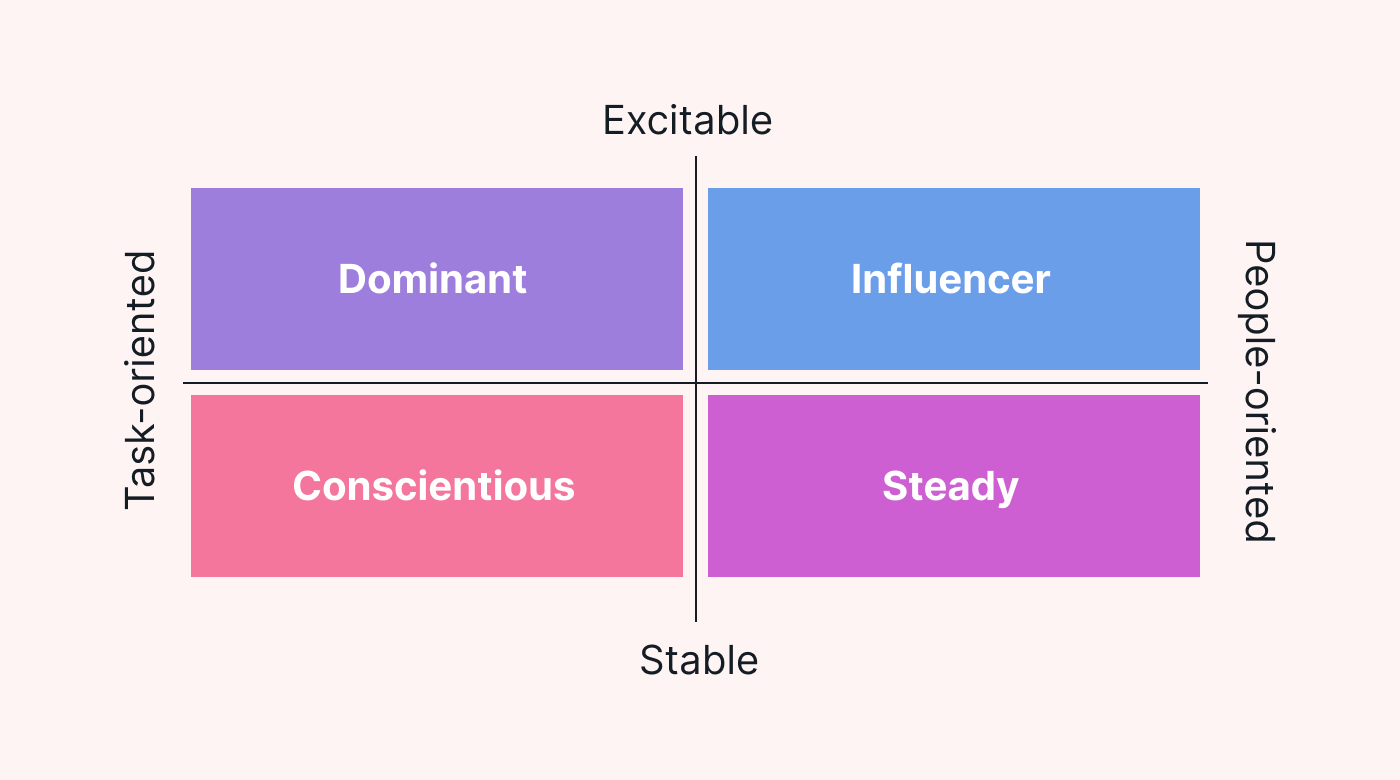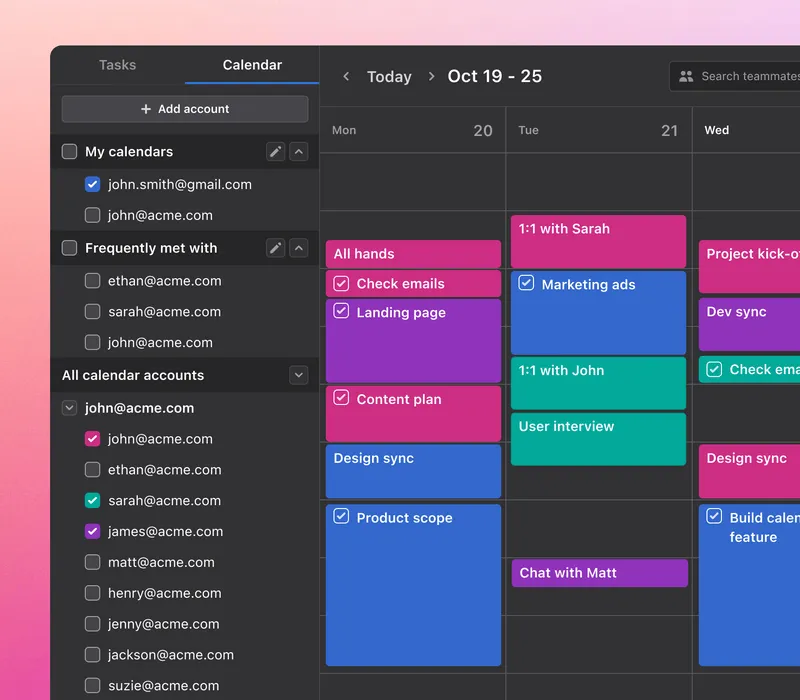Anyone in a team can communicate with their colleagues. Whether it’s a face-to-face conversation or sending an email, communication itself isn’t hard.
The trick is knowing how to communicate effectively. Without strong team communication, information can be misunderstood, vital information can be missed, and productivity can take a hit. As more people communicate, things can get tricky.
In this article, we’ll show you four simple but effective ways to improve communication with your team. We’ll also look at why team communication is important and the different types of communication to be aware of.
What is team communication?
Team communication is the exchange of information, ideas, and feedback among team members. When done well, it helps them achieve shared goals, coordinate activities, and collaborate effectively.
A good example of solid team communication could be a project team working together.
They communicate regularly in person and remotely via different channels during the project. As a result, the project team keeps everyone updated on progress and ensures the project is delivered on time and within budget.
Take a look at Motion’s project management calendar as an example. Team members can communicate with each other about project progress and share updates with the entire project team in one location.
 |
Find out more about our AI-powered calendar.
What is the communications channel formula?
The communications channel formula (also known as the N * (N–1) / 2 formula) helps you identify the potential number of communication opportunities in any work environment. In the formula, N represents the number of individuals or members in the team or group.
Let's say you have a team of 5 members. Here’s how this would look with the formula:
5 * (5–1) / 2
In this equation, you’d multiply 5 by 4, which equals 20. Then, you’d divide it by 2, which is 10:
5 (4) / 2 = 20 / 2 = 10
So in this example, a team of 5 has 10 potential communication channels.
The formula accounts for the fact that each person on the team needs to communicate with every other individual, but not themselves. This is where the (N-1) part comes into play. As a result, it offers a clear estimate of how many possible communication avenues there are through a project.
Project teams can plan their communication activities accordingly and ensure everything runs smoothly.
Why is effective team communication important?
Team communication is important for multiple reasons, including improving collaboration and effectively resolving problems.
Let’s look at these benefits (and a few others) in more detail.
To share accurate information
Strong communication allows team members to share up-to-date knowledge and resources to perform their tasks effectively.
Think about it. If a project team shares accurate updates on progress, the team is more likely to complete their work on schedule. Team members might experience delays, bottlenecks, and other challenges without communication around progress.
Sharing clear information also minimizes misunderstandings. There’s no room for interpretation because all the communication is as clear as possible. As a result, teams can work together as efficiently as possible and ensure all project activities run smoothly.
To improve collaboration
By communicating clearly and openly, team members can work together more efficiently. They avoid duplication of work, exchange ideas, discuss project requirements, and ensure everyone is on the same page.
It also helps team members work through problems together and make important decisions. For example, with clear communication, team members can discuss bottlenecks in the project and identify the best way to resolve the issue. As a result, they can improve their workflow and work together to deliver the project successfully.
To build trust
Effective communication among team members is the cornerstone of building trust. It fosters an environment of transparency, respect, and mutual understanding, leading to stronger relationships and higher trust among team members.
Building trust also involves active listening, which creates an environment where team members feel heard and understood. Again, this develops trust between team members, which helps them work together more effectively.
What are the types of team communication?
There are two main forms of communication: verbal and non-verbal.
 |
Let’s look at these in more detail.
Verbal communication
Verbal communication involves communicating with words, either in person, through video calls, or by sending voice notes. It includes conversations, team meetings, presentations, and discussions where individuals share thoughts, ideas, and emotions.
Unlike non-verbal communication, verbal communication focuses specifically on direct and explicit conversation. It allows individuals to clarify, ask questions, and engage in detailed discussions. It also involves using vocabulary, grammar, tone, and voice modulation to convey meaning.
For this reason, verbal communication is a good way to share updates and ask questions. It helps project teams understand what other team members want and what’s expected of them throughout the project.
Non-verbal communication
Non-verbal communication refers to the exchange of information without using words. Instead, you communicate through facial expressions, body language, gestures, posture, eye contact, proximity, and touch.
Non-verbal communication can significantly impact the way messages are interpreted and understood. Let’s look at body language as an example.
Think about someone slouching in a chair with their arms crossed. Their body language indicates that they’re bored or upset. But if they’re sitting upright, arms relaxed, and making eye contact, they appear much more engaged and interested.
In some situations, team members might resort to non-verbal communication if they feel uncomfortable, upset, or stressed. This is why it’s important to recognize non-verbal communication signs, such as body language and facial expressions.
If you don’t pick up on these cues, you might misunderstand their communications or fail to spot when someone struggles with their work and is unsure how to ask for help.
4 top tips to improve team collaboration
Let’s take a look at some of the best practices for team communication and collaboration.
1. Use clear and simple language
When it comes to communication, whether it’s talking face-to-face or sending an email, it’s vital that everyone on the entire team is as clear and direct as possible.
Why?
Because if you’re not, you leave things open to interpretation.
For example, imagine that your team leader asks you to write five reports by next week.
It sounds pretty clear, right? But there are still some unanswered questions:
- What are the reports about?
- How long should they be?
- How much detail do they need?
- When are they due next week?
If your team leader had said, “please create sales reports for our top five clients by the end of the day on Monday next week,” you would know exactly what the work involves.
Here are some ways to make sure you’re as clear and concise as possible with your communication:
- Use simple language. Don’t over-complicate things; use simple language to describe what you want to say. That way, there’ll be less confusion, and everyone will be on the same page.
- Be direct. Don’t beat around the bush with your communication. Sure, you can add some pleasantries to break the ice (like asking how someone is), but when it comes to what you need to say, be clear and direct. If you waffle, the person you’re talking to might misunderstand what you’re trying to say.
2. Understand the different team communication styles
Understanding the different communication styles when working in a team is important. It helps you better understand how different people communicate and how you can communicate with them as effectively as possible.
Here are some of the communication styles from the DISC framework:
 |
Let’s look at these in more detail.
- Dominant: People with a dominant communication style are direct, assertive, and results-oriented. They communicate in a straightforward manner, focusing on facts, actions, and outcomes, and they value efficiency. You can often spot this communication style in confident, decisive people who prefer to take charge in a group setting.
- Influencer: Individuals with an influencer communication style are enthusiastic, expressive, and people-oriented. They really enjoy social interactions and often use storytelling and engaging language to communicate their ideas and connect with others emotionally. You can usually spot the influencer communication style in people that are outgoing, good at building relationships, motivating others, and inspiring enthusiasm in their teammates.
- Conscientious: Those with a conscientious communication style are detail-oriented, analytical, and cautious. They prefer to gather and analyze information before expressing their thoughts. To pinpoint anyone with a conscientious communication style, look out for people who ask probing questions and seek clarity in their interactions.
- Steady: People with a steady communication style are supportive, patient, and cooperative. They value harmony, are good listeners, and strive to create a positive team environment. People who are typically warm, empathetic, and avoid conflict are usually steady communicators.
Individuals may have a combination of these communication styles, with one or two styles being more apparent. No matter what styles each person uses, by understanding what they are and how they work, you’ll be in a good position to effectively communicate with your team.
For example, if you can see that someone is communicating in a conscientious way, you can reciprocate that method of communication. As a result, you’ll build better relationships and improve the efficiency of project work.
3. Avoid passive communication
Passive communication is when someone avoids speaking up or expressing their thoughts and feelings. They may stay quiet, avoid conflict, and have difficulty asserting themselves or setting boundaries.
When it comes to team communication, passive communication can be a problem. It prevents you from saying what you really want to and stops you from getting your point across.
However, we know it’s not always easy to overcome passive communication — especially if you’re trying to avoid conflict. Here are a couple of best practices to help you and your team overcome this issue:
- Be proactive and share your thoughts: Take the initiative to express your thoughts, opinions, and needs in a clear and assertive manner. It might feel uncomfortable at first, but the more you practice being confident and proactive with your communication skills, the easier it’ll get.
- Try to set boundaries: Learn to assert your boundaries and express your needs and preferences. For example, saying "no" when necessary, using "I" statements to communicate your thoughts and feelings, and standing up for yourself to ensure your voice is heard. With these boundaries in place, you’re making it easier for yourself to communicate in a clear and direct way.
4. Use collaborative platforms
Collaborative tools make it easier for teams to communicate and work together. For example, if you’re using Motion’s calendar to manage your workload, everyone in the project team can use the platform to keep in touch and track project progress.
 |
But how exactly do you know which collaborative platforms to use?
The simple answer is to identify the features you need. Then, you can find platforms that fit the bill.
If you’re not sure which features you should be looking out for, don’t worry. Here are a couple of features we’d suggest keeping an eye out for in any team communication tool:
- Ease of use: If you’re using a platform that’s difficult to use, it’ll be hard for your project team to adopt. Find a tool with a simple interface that everyone can use without spending hours on training. Take a look at Motion as an example. Our calendar has a simple, intuitive interface that anyone can use. We also have an easy drag-and-drop feature so that team members can reshuffle their schedule in a matter of clicks. Plus, you can view other people’s calendars to see what they’re working on and how they’re progressing.
- Ability to communicate: Any collaborative tool should make it easy for you and your team to communicate, especially if you’re part of a remote team where face-to-face communication isn’t possible. This could include features like instant messaging, adding comments, or sharing updates with your team quickly and efficiently.
Use Motion to encourage open communication and improve collaboration
Effective workplace communication plays an important role in your company culture. It builds relationships between team members, improves collaboration, and makes sure that everyone’s working towards a common goal.
If you’re looking for a way to encourage open communication and boost employee engagement, consider using Motion. With our AI-powered calendar, teams can keep up to date with project progress, share updates, and tag other users in comments. Sign up for a free trial to see how it works.





